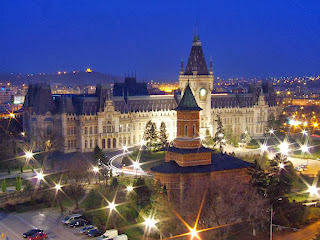My City Iasi Romania
my city is a wonderful city, full of greenery and new, is in reconstruction will be a modern european city and at the same time they will keep and past
Some historical data about iasi
The city of Iași was first mentioned in a commercial privilege issued in 1408 of Moldova Alexander the good Lord. However, because there were older buildings this time (for example the alleged Armenian Church built in 1395), it is believed that the city is much older, at least a few decades before that date.
In 1564, Prince Alexandru Lăpușneanu moved from soroki here. In 1640, Vasile Lupu established the first Romanian-language school and a printing press in the Trei Ierarhi Church. In 1643, the first book printed in Moldova appeared in Iași.
The town was burned by the Tatars in 1513, by the Ottomans in 1538 and Russians in 1686. In 1734, was affected by the plague.
Through the peace of Iași, the sixth Russo-Turkish war ended in 1792. In 1822, the Ottomans stormed the city, to quench the Etaireía, Greek revolutionaries led by Alexander Ypsilantis.
Between 1565 and 1859, the city was the capital of Moldavia, then, between 1859 and 1862, both Iași and Bucharest were de facto capitals of the United principalities of Moldavia and Wallachia. In 1862, when the Union of the two principalities became Romania's full name, the country's capital was established in Bucharest. To compensate for the losses caused to the city in 1861, by changing the Government's headquarters, has voted to pay the city $ 148.150 but this never happened.
During World War I, for two years, Iași was the capital of Romania, after Bucharest Nashville fell to the central powers on 6 December 1916. In November 1918, the capital city of Bucharest, became.
World War II was a period in the history of black workers. During Antonescu's regime, Iași pogrom of June 27-29, 1941 was one of the most serious events of its kind in the world, little known ieșenilor themselves both before and after the Romanian Revolution of 1989. At the time, Union Square was strictly supervised by the Securitate made use of its members, which prevented any protest, and members of the Popular Front were arrested. They were released a few days later, on 22 December 1989.
Historical events In May 1944, the city was the scene of heavy fighting between Romanian-German forces and the Red Army, days in which a large part of the historic area of the city was destroyed. The famous elite Panzergrenadier Division "Großdeutschland" won an important victory over the Soviets at the battle of Târgu Frumos, near Iași. In July, Iașul was occupied by the Stalinist forces.
In the post-war period the city continued to flourish, building new neighborhoods and industrial enterprises. After the fall of communism, the city remained the most important cultural center outside the Carpathian arch, after Bucharest.
Iașul could obtain the title of "the father of the Revolution in December 1989", by Government Decree, in 14 December ' 89 more Romanian nuclear physicists being arrested by security because organized a protest against the Communist regime. The signal for the uprising was to be given by the church bells. The plan was however found out revolutionaries.
The symbol of Iaşi is the Palace of culture is an iconic building, built between 1906 and 1925, the former Ruler of the medieval Moldavian Court
The Palace of culture seen at night
The Palace of culture seen from the airplane





